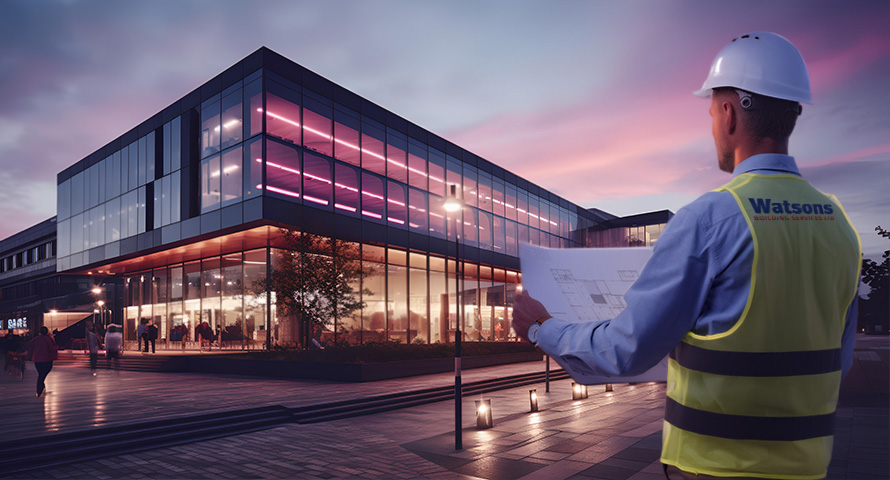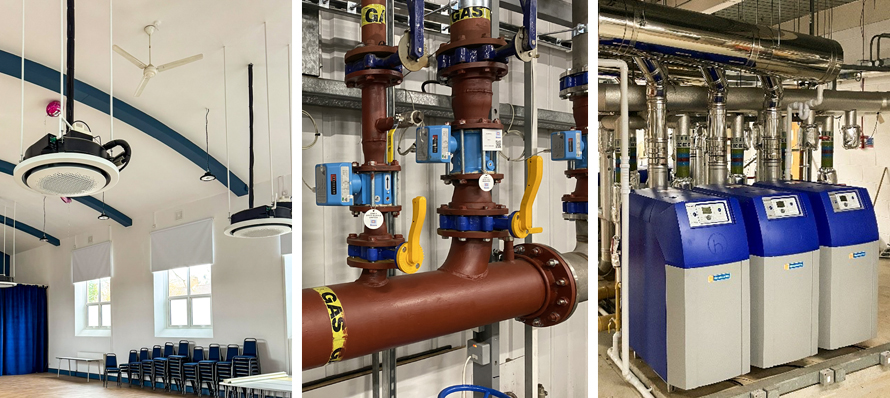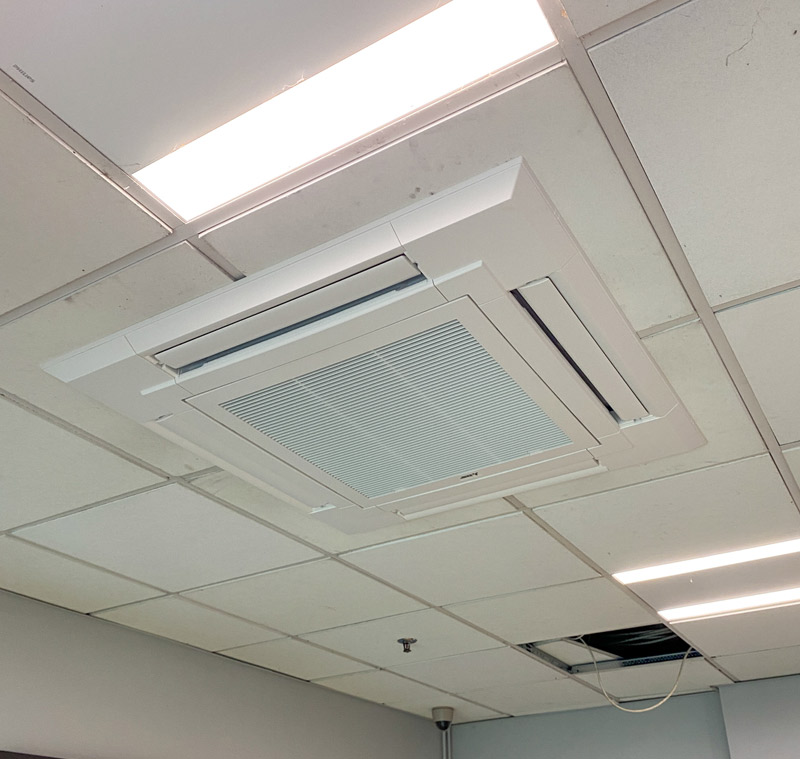- 01535 652338
- mail@watsonsbs.com

Essential Upgrade Strategies for Energy Efficiency
Upgrading ageing or inefficient building services in UK commercial, public sector, and industrial buildings isn’t just good for the environment; it’s smart business. According to the Department for Energy Security and Net Zero's Non-Domestic National Energy Efficiency Data Framework (ND-NEED) 2024, non-domestic buildings account for approximately 18% of the UK's energy consumption, with space heating, cooling, and hot water representing more than 50% of this.
Investing in these upgrades presents a real opportunity to lower energy costs, reduce carbon emissions, and enhance occupant comfort, delivering both environmental and financial benefits for building owners and managers. While comprehensive upgrades may seem complex or costly, a clear roadmap, careful planning, and focus on long-term returns make them a core part of any facility manager’s strategy.
Optimising HVAC
Heating, ventilation, and air conditioning (HVAC) systems often account for up to 60% of energy consumption in UK non-residential buildings. Upgrading these systems can significantly cut energy costs, reduce carbon emissions, and improve occupant comfort.
Heating: High-Efficiency Systems
Modern high-efficiency boilers and heat pumps provide reliable, low-carbon heating. Heat pumps, in particular, offer a Coefficient of Performance (COP) between 3 and 5, significantly reducing operating costs compared to legacy systems, while supporting decarbonisation goals.
Ventilation: Smart Air Management
Advanced ventilation systems, such as Mechanical Ventilation with Heat Recovery (MVHR), optimise indoor air quality and energy use. By extracting stale air and pre-conditioning incoming fresh air, these systems maintain a consistent, comfortable environment while minimising energy consumption.
Air Conditioning: Efficient Climate Control
Energy-efficient air conditioning systems maintain comfortable indoor temperatures year-round while controlling energy use. Variable-speed compressors, zoning, and smart controls reduce operational costs and enhance sustainability performance.

Building Management Systems (BMS)
Modern Building Management Systems (BMS) centralise the control of heating, cooling, lighting, and other building services. Advanced analytics, fault detection, and sub-metering optimise energy use, improve comfort, and reduce operational costs.
Accurate metering and sub-metering allow facilities managers to track energy and water use in real time, pinpoint wastage, and quantify the impact of upgrades. Establishing key performance indicators (KPIs) supports ongoing optimisation and compliance with regulatory reporting requirements.
Measured savings from BMS upgrades typically range from 10-30%. Early detection of faults reduces maintenance costs, extends equipment life, and allows facilities managers to target interventions efficiently. Sub-metering and pilot zones enable incremental deployment and rapid ROI.
Lighting
Lighting upgrades are among the fastest ways to achieve energy savings. Full LED retrofits, combined with occupancy sensors, daylight harvesting, and integration with BMS, can significantly reduce electricity consumption and operating costs.
LEDs consume 50-75% less energy than traditional lighting. Smart controls ensure lights are dimmed or switched off in unoccupied or naturally lit spaces, enhancing comfort while saving energy. Payback periods in UK commercial buildings typically range from 1-4 years, depending on operational hours.
Solar PV
Roof-mounted or canopy solar PV, paired with batteries or smart inverters, allows buildings to offset daytime electricity use, reduce costs, and lower Scope 2 carbon emissions. Flat-roofed offices, warehouses, and schools with south-facing exposure are particularly suitable for solar installations.
Typical payback for commercial PV systems in the UK is 4-8 years, with faster returns in facilities that have high daytime energy demand. Combining solar with energy storage can further enhance resilience and protect against rising energy prices.
Water & Wastewater
Water efficiency measures are a cost-effective way to reduce both utility bills and the carbon footprint of heating and pumping water. Low-flow taps, dual-flush toilets, leak detection, and rainwater harvesting for non-potable uses such as WC flushing and irrigation can deliver meaningful savings.
Rainwater harvesting is most effective where roof areas are large and demand is high, such as schools, warehouses, or facilities with washdown processes. Starting with simple fixture upgrades ensures rapid savings, with rainwater harvesting introduced where site-specific modelling shows clear benefits.

Watsons Building Services provides the technical expertise and project delivery capability for sustainable technologies such as air conditioning (left), BMS (centre) and heating (right).
Upgrade Implementation Strategies
Delivering effective sustainability upgrades demands a structured, strategic approach, from initial assessment through to ongoing optimisation. As many facilities cannot accommodate extended downtime, a phased implementation plan that targets specific systems in sequence ensures business continuity while progressively improving efficiency and reducing operational costs.
Strategic Priorities for Facilities and Building Managers
1 Start With Data
Begin with a commercial energy audit to establish a clear baseline for energy and water use. Accurate data enables informed decision-making, helping identify inefficiencies and prioritise investments that deliver the greatest operational and carbon reduction benefits.
2 Optimise Controls First
Enhance performance by upgrading or integrating building management systems (BMS), adding sub-metering, and deploying analytics dashboards for real-time insight. Improvements in control and monitoring often deliver the fastest returns, driving measurable energy savings with minimal disruption.
3 Target High-Use Systems
Focus on the largest energy consumers first, such as HVAC and lighting. Replacing legacy boilers with heat pumps, introducing MVHR systems, and switching to LED lighting can yield substantial reductions in both energy use and operational costs while improving comfort and reliability.
4 Integrate Renewables Strategically
Incorporate solar PV and battery storage to offset daytime electrical loads and strengthen resilience against rising energy costs. Align renewable generation with site demand patterns to maximise return on investment and long-term sustainability performance.
5 Improve Water Efficiency
Begin with simple upgrades, such as low-flow taps, dual-flush toilets, and leak detection, to reduce water use and associated energy costs. Advanced solutions, such as rainwater harvesting, can be considered once basic measures are in place.
CASE STUDY SPOTLIGHT
Energy-Efficient Air Conditioning Upgrade at a Logistics Centre in West Yorkshire
Watsons completed a multi-floor office Air Conditioning system upgrade for a long-standing client in West Yorkshire. We delivered turnkey HVAC solutions, from design and installation through to ongoing maintenance, while prioritising energy efficiency, operational continuity, and client satisfaction.
Innovation, Expertise, Excellence: A Proven Partner In Sustainable Building Services
With decades of experience in building services design, installation, and commissioning, Watsons Building Services provides the technical expertise and project delivery capability to turn sustainability ambitions into reality.
From initial consultation and system design to installation and ongoing optimisation, Watsons ensures each solution is tailored to meet the specific operational, environmental, and financial goals of every client, helping buildings perform better, longer, and more sustainably.
Need to upgrade your facilities building services?
Connect with Watsons Building Services and discover how our expertise and experience can help strategically plan essential upgrades.


